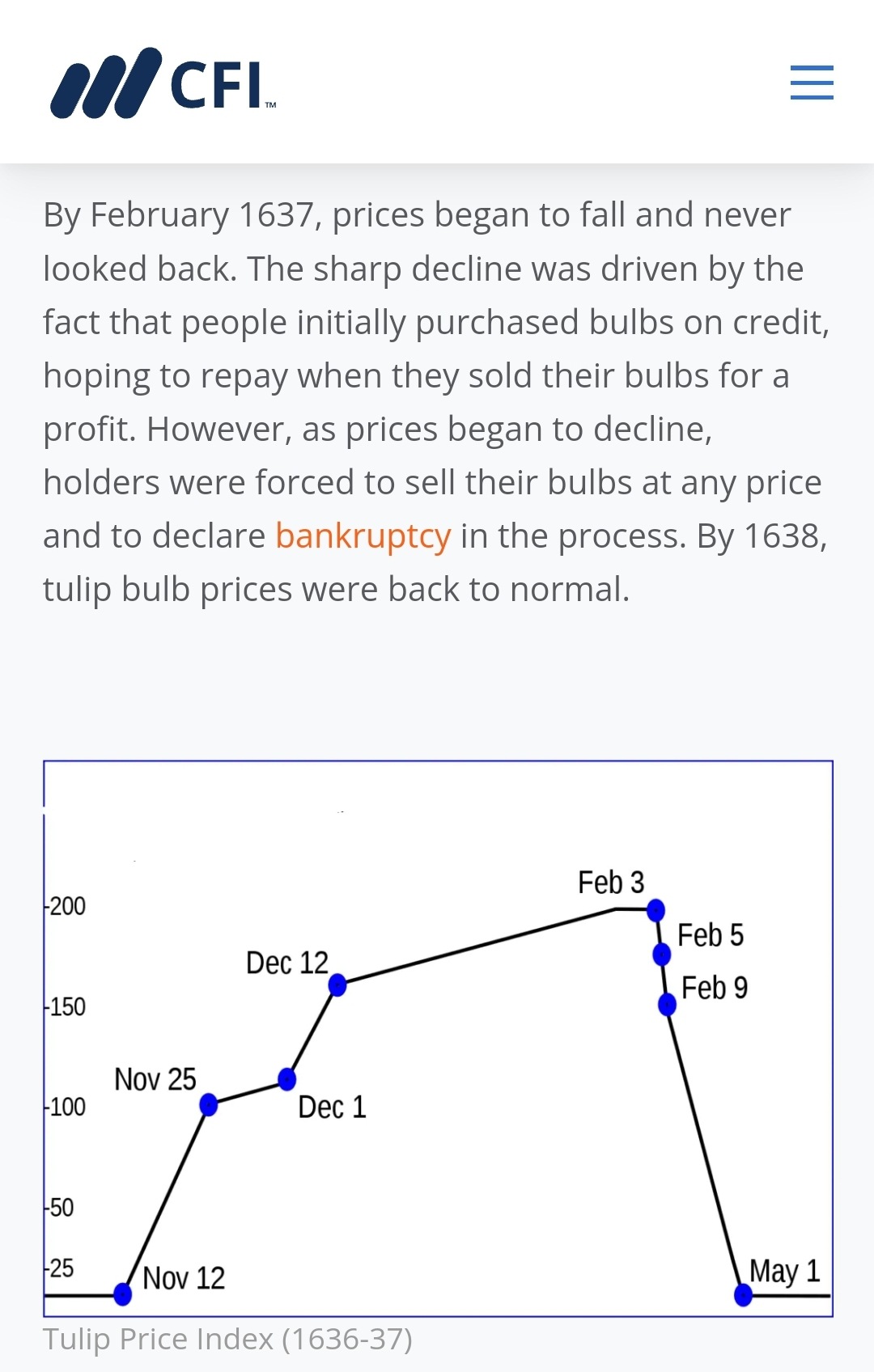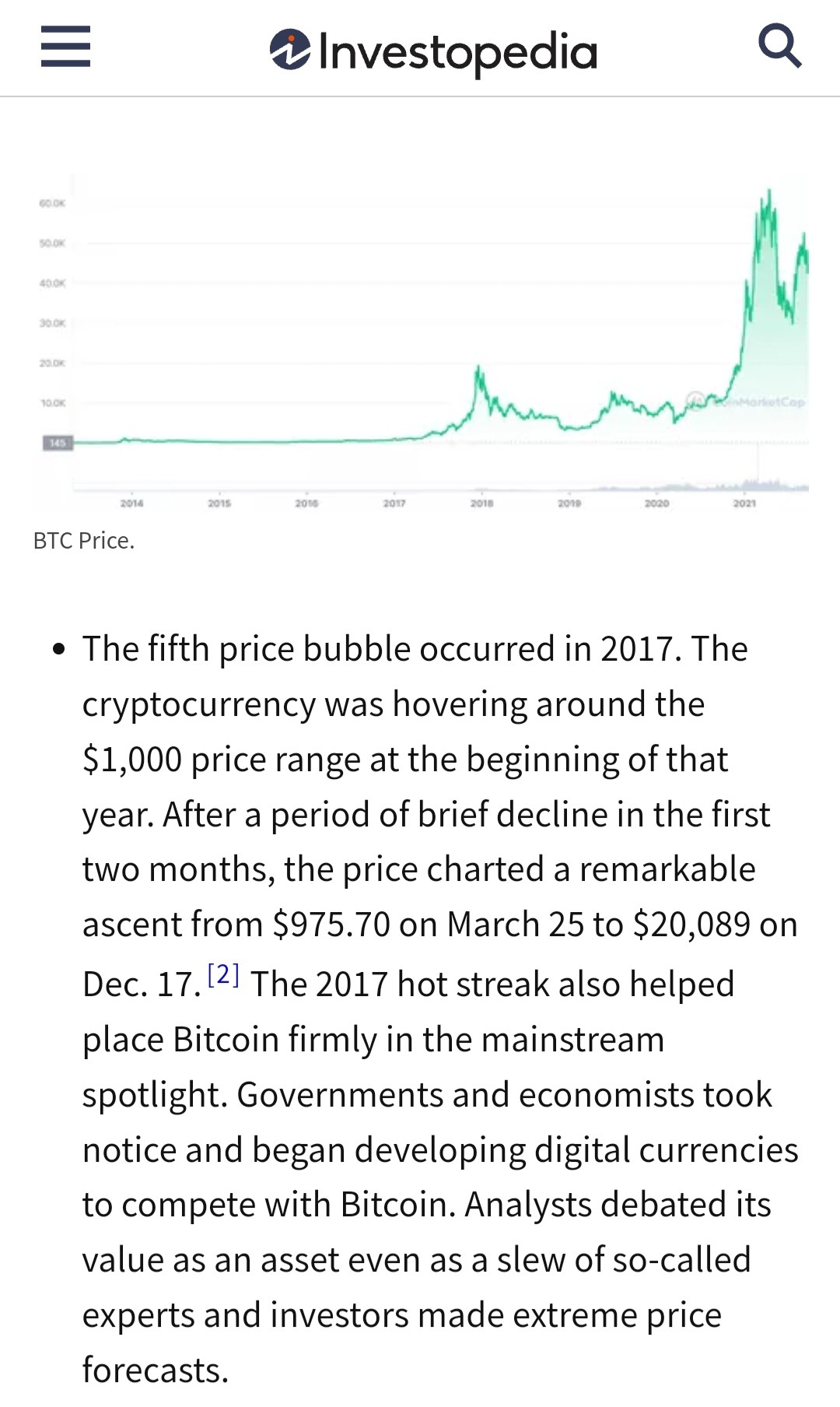
[永遠的奧古斯都] 史上第一次經濟危機:鬱金香泡沫
永遠的奧古斯都
204 回覆
77 Like
4 Dislike

元宇宙隻5m HKD遊艇

可唔可以講下泡沫爆破原因同泡沫爆破之前發生咗啲咩事  ?
?
 ?
?因為啲人本身用「票據」做買賣,類似碌信用卡咁。以「票據」形式低買高賣,還錢後嘅差價,就係獲利。當價格太高,搵唔到「下一個笨蛋」,整個期貨系統就會崩潰。

https://corporatefinanceinstitute.com/resources/knowledge/economics/dutch-tulip-bulb-market-bubble/

https://corporatefinanceinstitute.com/resources/knowledge/economics/dutch-tulip-bulb-market-bubble/
冇份狂熱嘅就會覺得係scam
有份貪嘅就會覺得自己買得好抵
有份貪嘅就會覺得自己買得好抵

Bitcoin長遠一定係升
“It’s a bubble.”
A bubble is an economic cycle that is characterized by the rapid escalation of market value, particularly in the price of assets. This fast inflation is followed by a quick decrease in value, or a contraction, that is sometimes referred to as a "crash" or a "bubble burst." Typically, a bubble is created by a surge in asset prices that is driven by exuberant market behavior. During a bubble, assets typically trade at a price, or within a price range, that greatly exceeds the asset's intrinsic value (the price does not align with the fundamentals of the asset).
An asset going through bubble phases doesn’t make it fraudulent. Bubbles can occur in all assets, including fiat currencies, commodities, real estate and equities.
Bitcoin has experienced four major cycles of massive 1000%+ appreciation, followed by deep drawdowns of more than 80%. Each cycle has started from a much higher price than the previous one. This is not a characteristic of one-time manias. Bitcoin's price, as well as fundamental adoption numbers, are increasing dramatically over multi-year timeframes.
It is a common refrain from people ignorant of both bitcoin, as well the dutch tulip bubble, to refer to bitcoin as "tulips". The tulip bubble was a one-time event, lasting a couple months at manic prices, and affecting relatively few people. Bitcoin, by sharp contrast, is exhibiting growth characteristics - both in price and adoption metrics - similar to an increasingly dominant tech company or protocol.
“It’s a bubble.”
A bubble is an economic cycle that is characterized by the rapid escalation of market value, particularly in the price of assets. This fast inflation is followed by a quick decrease in value, or a contraction, that is sometimes referred to as a "crash" or a "bubble burst." Typically, a bubble is created by a surge in asset prices that is driven by exuberant market behavior. During a bubble, assets typically trade at a price, or within a price range, that greatly exceeds the asset's intrinsic value (the price does not align with the fundamentals of the asset).
An asset going through bubble phases doesn’t make it fraudulent. Bubbles can occur in all assets, including fiat currencies, commodities, real estate and equities.
Bitcoin has experienced four major cycles of massive 1000%+ appreciation, followed by deep drawdowns of more than 80%. Each cycle has started from a much higher price than the previous one. This is not a characteristic of one-time manias. Bitcoin's price, as well as fundamental adoption numbers, are increasing dramatically over multi-year timeframes.
It is a common refrain from people ignorant of both bitcoin, as well the dutch tulip bubble, to refer to bitcoin as "tulips". The tulip bubble was a one-time event, lasting a couple months at manic prices, and affecting relatively few people. Bitcoin, by sharp contrast, is exhibiting growth characteristics - both in price and adoption metrics - similar to an increasingly dominant tech company or protocol.
Bitcoin 嘅本質係去中心化加密貨幣,只要有人信就可以作為交易媒介,就會有佢嘅價值。
同16世紀鬱金香唔同嘅地方,係鬱金香最大價值係觀賞同地位象徵,姐係冇乜實質價值。
不過Bitcoin 都有唔同嘅bubble events,但唔代表整個Bitcoin 系統係一個bubble。
同16世紀鬱金香唔同嘅地方,係鬱金香最大價值係觀賞同地位象徵,姐係冇乜實質價值。
不過Bitcoin 都有唔同嘅bubble events,但唔代表整個Bitcoin 系統係一個bubble。

暴跌原因?
市價遠超實際價值,冇人接貨冇需求
交易量少,或者恐慌性拋售都會暴跌
交易量少,或者恐慌性拋售都會暴跌
個道理差唔多
如果還唔到銀行啲債就仲大獲

如果還唔到銀行啲債就仲大獲
但bitcoin太全球化
暫時仲好易搵笨蛋
覺得而家係用槓桿入場 頂下個價咁
現價入場門檻都算幾高
暫時仲好易搵笨蛋

覺得而家係用槓桿入場 頂下個價咁
現價入場門檻都算幾高
全球咁去中心化就係佢個概念
要全球同一時間都對Bitcoin冇信心先會冇價值

要全球同一時間都對Bitcoin冇信心先會冇價值
本質係去中心化加密貨幣
但當政府干預(要經政府中心化/禁交易/當你洗黑錢)就失去你所講既用途
由枱面轉番去枱底
就產生 仲有冇人信既問題
但當政府干預(要經政府中心化/禁交易/當你洗黑錢)就失去你所講既用途
由枱面轉番去枱底
就產生 仲有冇人信既問題
當國家層面覺得Bitcoin威脅到政權
就乜幣都死

就乜幣都死

香港人收入中位數係30000美金一年
所以覺得去中心化呢樣野 好難實現
國家層面/當權者利益已經會攪9你
同埋而家有幾多入市係 因為去中心化 既目標而入丫
反而投機者太多 其本質已變 由去中心化思想 變左搵錢

國家層面/當權者利益已經會攪9你
同埋而家有幾多入市係 因為去中心化 既目標而入丫
反而投機者太多 其本質已變 由去中心化思想 變左搵錢
最麻煩係
炒CRYTO班撚屌一方面就話要去中心化唔比金融體系控制
一方面CRYTO爆個時又會炸埋個金融體系同政府
正仆街黎
炒CRYTO班撚屌一方面就話要去中心化唔比金融體系控制
一方面CRYTO爆個時又會炸埋個金融體系同政府
正仆街黎
唔太明 呢句
CRYTO爆個時又會炸埋個金融體系同政府
姐係點?
CRYTO爆個時又會炸埋個金融體系同政府
姐係點?
姐係嗰陣最cheap嗰支花都賣90k鎂

所以理想歸理想
幾好嘅理念都係比貪婪(炒家)同嗜權(國家政權)嘅人所摧毀

幾好嘅理念都係比貪婪(炒家)同嗜權(國家政權)嘅人所摧毀

屌 好撚似而家d幣



左手交右手,睇下有沒人join. 做大左就肥肥